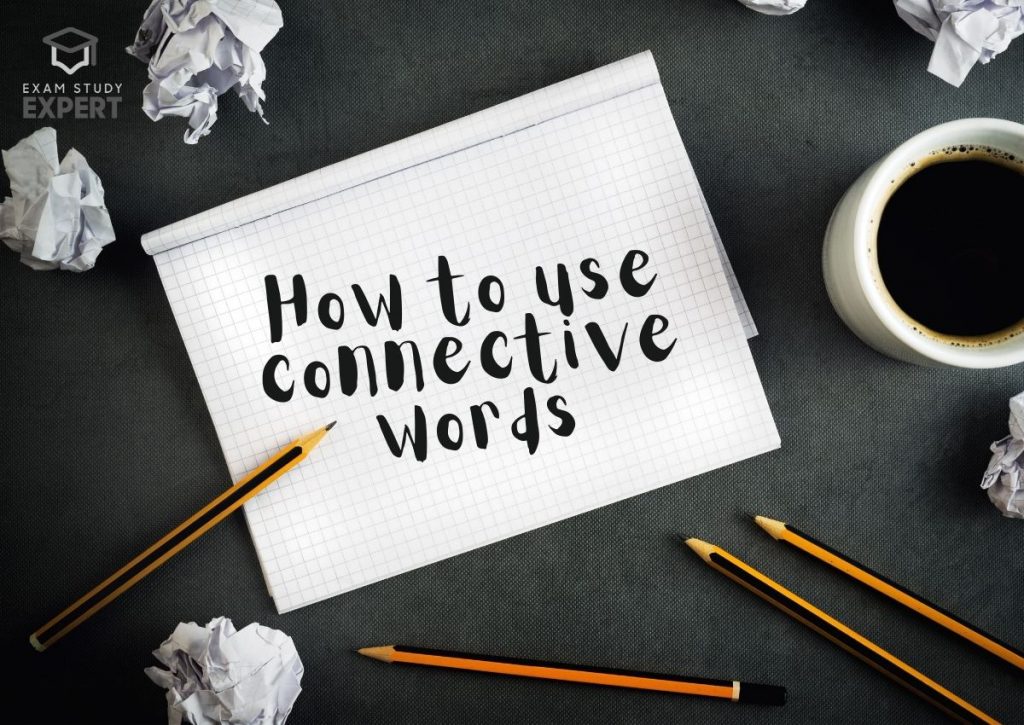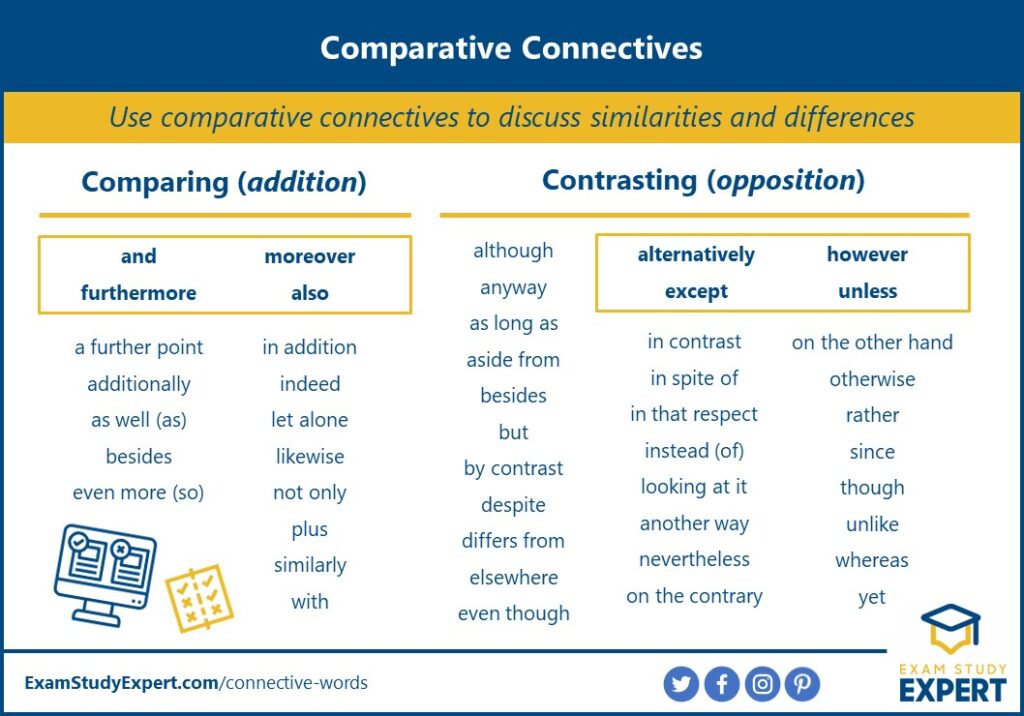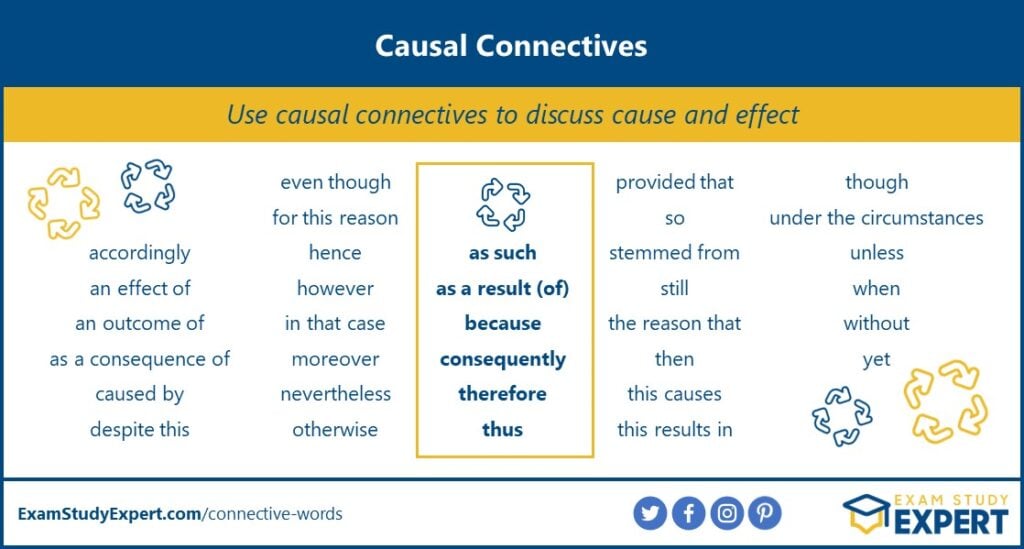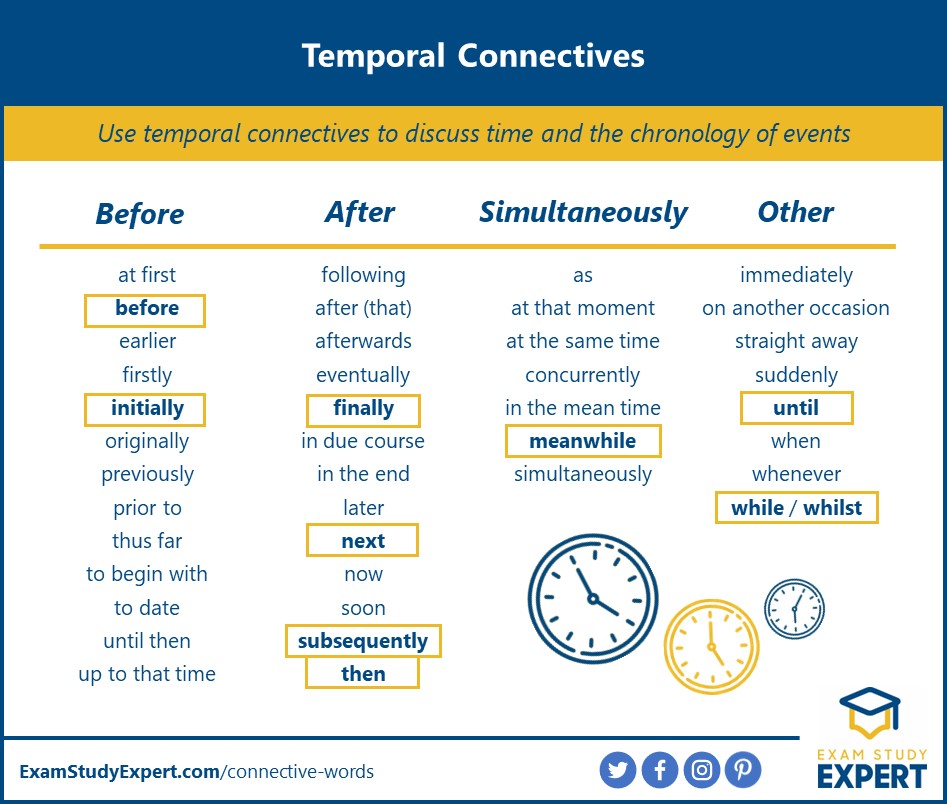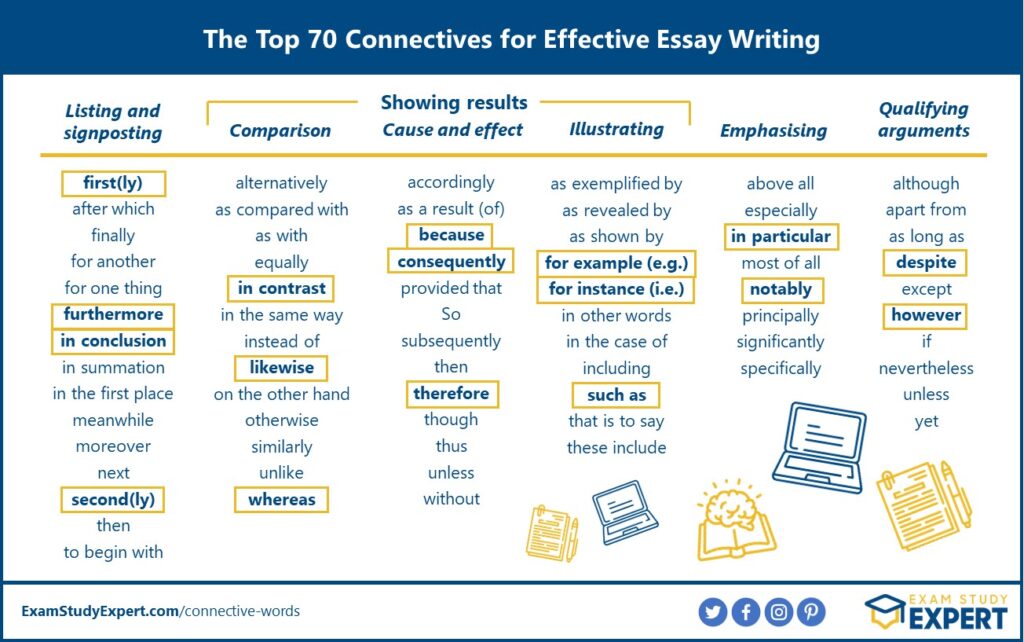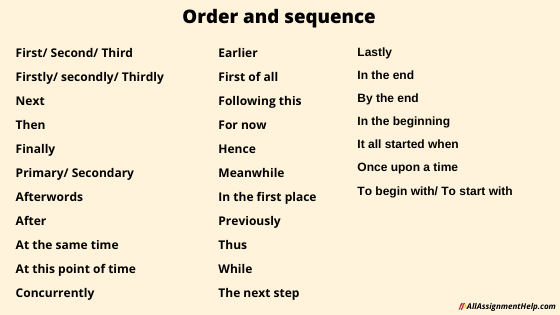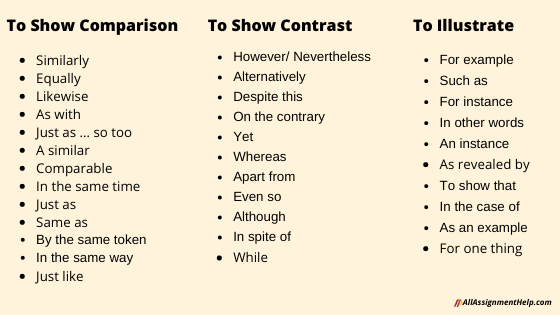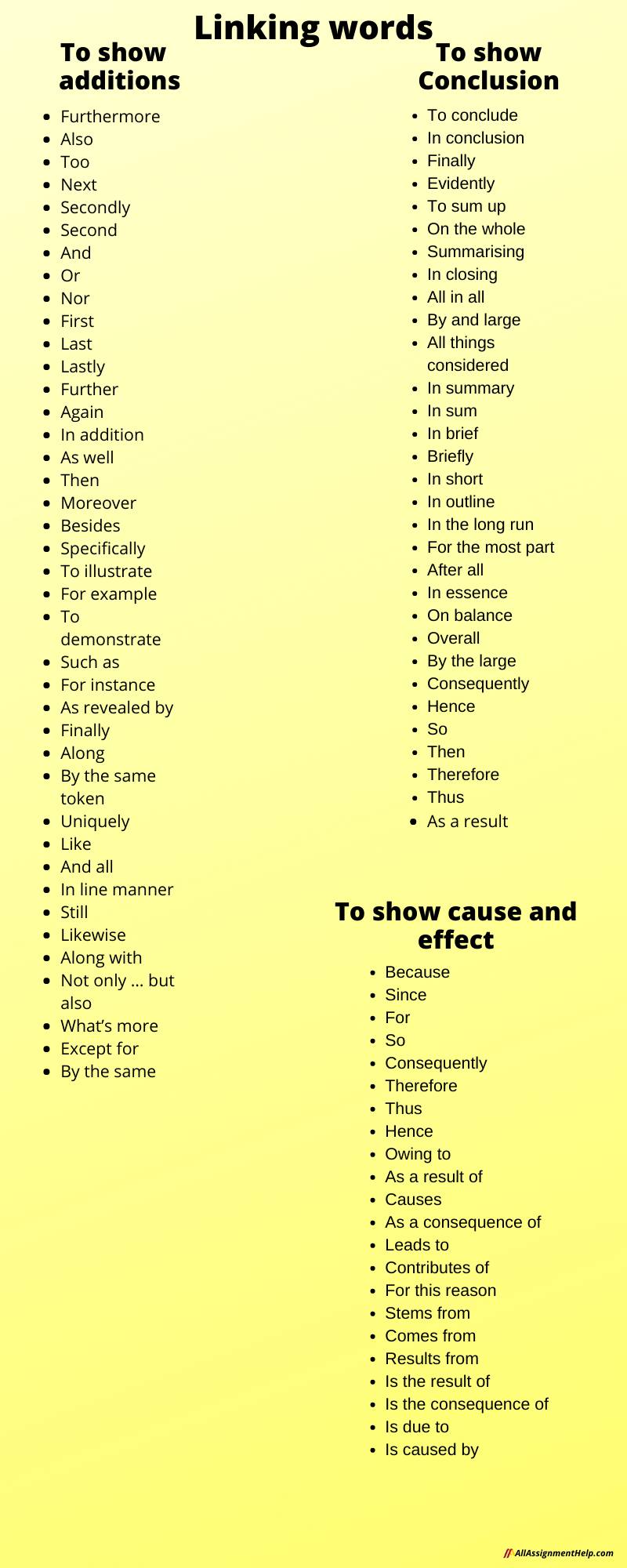Linking words and phrases are used to show relationships between ideas. They can be used to join two or more sentences or clauses.
We can use linking words to give a result, add information, summarize, give illustrations, emphasize a point, sequence information, compare or to contrast idea.
In this article, you will learn about the most common linking words and phrases:
Giving a Result
Usage: To provide the result of what has been stated or has occurred
Linking Words:
- As a result
- As a consequence
- Therefore
- Thus
- Consequently
- Hence
- For this reason
- Due to
Examples:
- His wife left him. As a result, he became very depressed.
- She has lived in France, and as a consequence she speaks French fluently.
- We do not have enough money. Therefore we cannot afford to buy the new car.
- We do not own the building. Thus, it would be impossible for us to make any major changes to it.
- There has been a great deal of rain and consequently the reservoirs are full.
- The customer was displeased with her meal, hence the chef prepared a replacement.
- For this reason, they are not a good choice for exterior use.
- Due to a broken wing, this bird can’t fly.
Adding Information
Usage: To add to what has been previously stated
Linking Words:
- Additionally / an additional
- Furthermore
- Also
- Too
- As well as that
- Along with
- Besides
- In addition
- Moreover
- In addition to this
- Apart from this
Examples:
- Additionally, the bus service will run on Sundays, every two hours.
- He said he had not discussed the matter with her. Furthermore, he had not even contacted her.
- We are unable to repair this watch. Also, this is the fourth time this has happened.
- I love wearing earrings. I design and make them too.
- We went to the park today. As well as that, we did some shopping.
- Along with parties and parliaments, elections have lost their charm.
- I can’t afford to go to the concert. Besides, I don’t really like classical music.
- You haven’t paid the rent yet. In addition, you owe me money.
- The report is badly presented. Moreover, it contains inaccuracies.
- John’s grades are terrible because he has been so lazy these days. In addition to this, his relationship to his parents got worse.
- Apart from this paragraph, the report contains a number of sensible initiatives.
Summarizing
Usage: To sump up what has been previously stated
Linking words:
- In conclusion
- To summarize
- Altogether
- In short
- To sum up
- In summary
- Briefly
- To conclude
Examples:
- In conclusion, walking is a cheap, safe, enjoyable and readily available form of exercise.
- To summarize, this is a clever approach to a common problem.
- The food was good and we loved the music. Altogether it was a great evening.
- His novels belong to a great but vanished age. They are, in short, old-fashioned.
- To sum up, there are three main ways of tackling the problem…
- In summary, this was a disappointing performance.
- Briefly, our team is now one of the best in the world.
- To conclude, I want to wish you all a very happy holiday season.
Giving Examples
Usage: To provide examples
Linking words:
- For example/ For instance
- Such as
- Including
- Namely
- In this case
- Proof of this
- Like
Examples:
- There are many interesting places to visit in the city, for example/ for instance, the botanical garden or the art museum.
- I prefer to wear casual clothes, such as jeans and a sweatshirt.
- Including Christmas Day and Boxing Day, I’ve got a week off work.
- We need to concentrate on our target audience, namely women aged between 20 and 30.
- I think I would have made a difference in this case.
- This building are a living proof of this existence, so we must preserve it.
- I also make other jewellery like rings and bracelets.
Emphasizing a Point
Usage: To put forward a point or idea more forcefully
Linking words:
- Undoubtedly
- Indeed
- Obviously
- Particularly / in particular
- Especially
- Clearly
- Importantly
- Absolutely
- Definitely
- Without a doubt
- Never
- It should be noted
- Unquestionably
- Above all
- Positively
Examples:
- Undoubtedly, the story itself is one of the main attractions.
- I don’t mind at all. Indeed, I would be delighted to help.
- Obviously, we don’t want to spend too much money.
- I love silver earrings, in particular ones from Mexico
- The car is quite small, especially if you have children.
- Clearly, this will cost a lot more than we realized.
- More importantly, can he be trusted?
- He’s an absolutely brilliant cook.
- I definitely remember sending the letter.
- We still believe we can win this series without a doubt.
- I’m never surprised at what I do.
- It should be noted that if you have something to note, then note it
- Unquestionably, teaching has been a paramount part of his career.
- Above all, this forest is designed for wear and tear.
- This is positively the worst thing that I can even imagine.
Sequencing Ideas
Usage: To indicate the order of what is being said
Linking words:
- First/ firstly (Second/ secondly, Third/ thirdly, Finally)
- At this time
- Following
- Previously
- Before
- Subsequently
- Above all
- Lastly and most importantly
- Last but not least
- First and foremost
Examples:
- Firstly, I prefer the train because I can see the landscape.
- At this time, the young man leapt into the air and flew off towards sunset.
- They arrived on Monday evening and we got there the following day.
- I had visited them three days previously.
- Your name is before mine on the list.
- Subsequently, new guidelines were issued to all employees.
- Above all, keep in touch.
- Lastly, and most importantly, you should be optimistic.
- Last but not least, I find I seriously cannot relate to women.
- We will continue to focus on our players first and foremost.
Comparing Ideas
Usage: To show how things are similar
Linking words:
- Similarly
- Equally
- Likewise
- Just as
- Just like
- Similar to
- Same as
- Compare / compare(d) to(with)
- By the same token
- In the same way
- Correspondingly
Examples:
- Similarly, the basketball and hockey games draw nearly full attendance.
- Equally, not all customers are honest.
- Her second marriage was likewise unhappy.
- She’s just as smart as her sister.
- Working with housecats is just like working with lions or tigers.
- Some people say I have a running style similar to him.
- Having a power is not the same as using the power.
- He gets the ball off quickly compared to two years ago.
- Teenagers should be more respectful; by the same token, parents should be more understanding.
- Alex enjoys telling jokes; in the same way/similarly/likewise,his son adores funny stories.
- Correspondingly, the roles each of them played were soon different.
Contrasting Ideas
Usage: To show how things are different
Linking words:
- Unlike
- Nevertheless
- On the other hand
- Nonetheless
- Despite / in spite of
- In contrast (to)
- Alternatively
- Conversely
- Even so
- Differing from
- Contrary to
Examples:
- Unlike most systems, this one is very easy to install.
- There is little chance that we will succeed in changing the law. Nevertheless, it is important that we try.
- Laptops are convenient; On the other hand, they can be expensive.
- The problems are not serious. Nonetheless, we shall need to tackle them soon.
- Despite/ In spite of the rain, I went for a walk.
- In contrast to the diligent bee, the butterfly flies hither and yon with no apparent purpose.
- The agency will make travel arrangements for you. Alternatively, you can organize your own transport.
- Northern European countries had a great summer. On the contrary/conversely, Southern Europe had poor weather.
- Even so, many old friends were shocked at the announcement.
- Differing from his white colleagues, he preferred instructing his scholars to the ambition of acquiring personal renown.
- The situation in Ireland is quite contrary to this principle.
Transition Words and Phrases
It is essential to understand how transition words, as a part of speech, can be used to combine ideas in writing — and thus ensure that ideas within sentences and paragraphs are elegantly connected — for the benefit of the reader. This will help to improve your writing (e.g. essay, comment, summary (scientific) review, (research) paper, letter, abstract, report, thesis, etc.).
It is also fundamental to be aware of the sometimes subtle meaning of transition words within the English language.
List of Transition Words
This structured list of commonly used English connecting words — approximately 200, can be considered as quasi complete. It can be used (by students and teachers alike) to find the right expression. English transition words are essential, since they not only connect ideas, but also can introduce a certain shift, contrast or opposition, emphasis or agreement, purpose, result or conclusion, etc. in the line of argument.
The transition words and phrases have been assigned only once to somewhat artificial categories, although some words belong to more than one category.
There is some overlapping with preposition and postposition, but for the purpose of clarity and completeness of this concise guide, I did not differentiate.
Agreement / Addition / Similarity
The transition words like also, in addition, and, likewise, add information, reinforce ideas, and express agreement with preceding material.
in the first place
not only … but also
as a matter of fact
in like manner
in addition
coupled with
in the same fashion / way
first, second, third
in the light of
not to mention
to say nothing of
equally important
by the same token
again
to
and
also
then
equally
identically
uniquely
like
as
too
moreover
as well as
together with
of course
likewise
comparatively
correspondingly
similarly
furthermore
additionally
Opposition / Limitation / Contradiction
Transition phrases like but, rather and or, express that there is evidence to the contrary or point out alternatives, and thus introduce a change the line of reasoning (contrast).
although this may be true
in contrast
different from
of course …, but
on the other hand
on the contrary
at the same time
in spite of
even so / though
be that as it may
then again
above all
in reality
after all
but
(and) still
unlike
or
(and) yet
while
albeit
besides
as much as
even though
although
instead
whereas
despite
conversely
otherwise
however
rather
nevertheless
nonetheless
regardless
notwithstanding
Cause / Condition / Purpose
These transitional phrases present specific conditions or intentions.
in the event that
granted (that)
as / so long as
on (the) condition (that)
for the purpose of
with this intention
with this in mind
in the hope that
to the end that
for fear that
in order to
seeing / being that
in view of
If
… then
unless
when
whenever
while
because of
as
since
while
lest
in case
provided that
given that
only / even if
so that
so as to
owing to
inasmuch as
due to
Examples / Support / Emphasis
These transitional devices (like especially) are used to introduce examples as support, to indicate importance or as an illustration so that an idea is cued to the reader.
in other words
to put it differently
for one thing
as an illustration
in this case
for this reason
to put it another way
that is to say
with attention to
by all means
important to realize
another key point
first thing to remember
most compelling evidence
must be remembered
point often overlooked
to point out
on the positive / negative side
with this in mind
notably
including
like
to be sure
namely
chiefly
truly
indeed
certainly
surely
markedly
especially
specifically
expressively
surprisingly
frequently
significantly
in fact
in general
in particular
in detail
for example
for instance
to demonstrate
to emphasize
to repeat
to clarify
to explain
to enumerate
such as
Effect / Consequence / Result
Some of these transition words (thus, then, accordingly, consequently, therefore, henceforth) are time words that are used to show that after a particular time there was a consequence or an effect.
Note that for and because are placed before the cause/reason. The other devices are placed before the consequences or effects.
as a result
under those circumstances
in that case
for this reason
for
thus
because the
then
hence
consequently
therefore
thereupon
forthwith
accordingly
henceforth
Conclusion / Summary / Restatement
These transition words and phrases conclude, summarize and / or restate ideas, or indicate a final general statement. Also some words (like therefore) from the Effect / Consequence category can be used to summarize.
as can be seen
generally speaking
in the final analysis
all things considered
as shown above
in the long run
given these points
as has been noted
in a word
for the most part
after all
in fact
in summary
in conclusion
in short
in brief
in essence
to summarize
on balance
altogether
overall
ordinarily
usually
by and large
to sum up
on the whole
in any event
in either case
all in all
Time / Chronology / Sequence
These transitional words (like finally) have the function of limiting, restricting, and defining time. They can be used either alone or as part of adverbial expressions.
at the present time
from time to time
sooner or later
at the same time
up to the present time
to begin with
in due time
until now
now that
as soon as
as long as
in the meantime
in a moment
without delay
in the first place
all of a sudden
at this instant
immediately
quickly
finally
after
later
last
until
till
since
then
before
hence
since
when
once
about
next
now
formerly
suddenly
shortly
henceforth
whenever
eventually
meanwhile
further
during
first, second
in time
prior to
forthwith
straightaway
by the time
whenever
instantly
presently
occasionally
Many transition words in the time category (consequently; first, second, third; further; hence; henceforth; since; then, when; and whenever) have other uses.
Except for the numbers (first, second, third) and further they add a meaning of time in expressing conditions, qualifications, or reasons. The numbers are also used to add information or list examples. Further is also used to indicate added space as well as added time.
Space / Location / Place
These transition words are often used as part of adverbial expressions and have the function to restrict, limit or qualify space. Quite a few of these are also found in the Time category and can be used to describe spatial order or spatial reference.
in the middle
to the left/right
in front of
on this side
in the distance
here and there
in the foreground
in the background
in the center of
adjacent to
opposite to
here
there
next
where
from
over
near
above
below
down
up
under
further
beyond
nearby
wherever
around
between
before
alongside
amid
among
beneath
beside
behind
across
Connecting Words
Transition Words & Phrases
Transition Words are also sometimes called (or put in the category of) Connecting Words.
Usage of Transition Words in Essays
Transition words and phrases are vital devices for essays, papers or other literary compositions. They improve the connections and transitions between sentences and paragraphs. They thus give the text a logical organization and structure (see also: a List of Synonyms).
All English transition words and phrases (sometimes also called ‘conjunctive adverbs’) do the same work as coordinating conjunctions: they connect two words, phrases or clauses together and thus the text is easier to read and the coherence is improved.
Usage: transition words are used with a special rule for punctuation: a semicolon or a period is used after the first ‘sentence’, and a comma is almost always used to set off the transition word from the second ‘sentence’.
Example 1:
People use 43 muscles when they frown; however, they use only 28 muscles when they smile.
Example 2:
However, transition words can also be placed at the beginning of a new paragraph or sentence — not only to indicate a step forward in the reasoning, but also to relate the new material to the preceding thoughts.
Use a semicolon to connect sentences, only if the group of words on either side of the semicolon is a complete sentence each (both must have a subject and a verb, and could thus stand alone as a complete thought).
When you’re writing an essay or assignment, you need to use every trick in the book to maximise your marks. And one of the best tools for radically improving your writing is the power of connective words.
Used correctly, connective words can give your writing new depth and meaning, improve readability (important for your examiner!) and demonstrate the logic of your arguments.
Luckily for you, we’ve got plenty of categories, definitions and connectives examples to help you get started…
Table Of Contents
- What are connective words?
- How to use connective words
- Types of connective words
- The TOP 70 connective words for effective essay writing!
- Good luck with your essay!
- The Science Of Studying Smart
Psst – this article uses loads of connectives. See if you can spot them in use: we’ve italicised the best examples!
What are connective words?
Simply put, connectives are words – or phrases – that link parts of your writing together.
You’re probably familiar with the most common connective words: and, as, because, but, if, or, so. In fact, I’ve used a few of them already – did you spot them?
Don’t limit your essay writing to the basics though, because there are hundreds of connectives that can help you to demonstrate different ideas, such as cause and effect, or the chronology of events.
We’re going to explore ten types of connectives below, but first, here’s a quick refresher on the grammar behind connective words:
Definitions: The grammatical bit
Understanding the grammar behind your writing might not be your thing – but bear with me, because remembering these six definitions will help you know which connective to use when, and where to place them!
(If you’re just looking for examples of connectives, feel free to skip straight past this bit!)
Connectives fall into three grammatical categories: conjunctions, prepositions, and adverbs.
- Conjunctions: are a type of connective BUT they’re not the same. Conjunctions join words, phrases, clauses and sentences together to form longer complex sentences.
- For example: and, but, for, or, yet.
- Today, I finished my history assignment but forgot to workout.
- Prepositions: describe the relative location, place and time between two things. They demonstrate time and space, direction and agency.
- Such as: at, in, of, on, under.
- I need to finish the conclusion of my essay before I go to dinner.
- Adverbs: modify verbs, adjectives and clauses. Adverbs explain how an action is carried out by adding detail, describing manner, and showing the how, when, where and why of the action.
- For instance: upwards, quickly, fortunately.
- My deadline is tomorrow. Fortunately, I proofread my thesis chapter already.
Using adverb and preposition connective words adds specific meaning – and thus clarity – to your writing. They are particularly useful for successful essay signposting.
Definitions part 2: Connectives in sentences
When using connectives, it’s also important to remember that not all sentences are created equal in importance. And so, when connecting them into longer sentences, different types of connectives create different results:
- Co-ordinating connectives: link phrases and clauses of equal importance to create compound sentences.
- For example: I find French tricky but I love learning Spanish.
On the other hand,
- Subordinating connectives: connect main clauses and subordinate clauses to create complex sentences.
- A subordinate clause relies on the main clause to make sense. Therefore, these connectives give information about the relationship between the clauses by specifying an order or place to events, or a cause and effect link.
- Here’s an example: I need to do my homework if I want to get a good grade.
A useful type of subordinating connective for essay writing is the:
- Sequencing connective: which will help you establish the logical sequence of events/ideas, or demonstrate a chronological order. Great for signposting!
- For instance: Firstly, I carried out the experiment, and secondly, I analysed the results.
And that’s your grammar refresh done!
If you’re struggling with essay-writing grammar, a great tool for checking your writing is Grammarly * – we use it at Exam Study Expert because it catches a broad range of mistakes. Their blog is also a great place to learn how to use conjunctions, prepositions, adverbs and more.
How to use connective words
So how do you go about using connectives?
In this section, we’re going to discuss the where, what and how …
Where to add connectives:
As we’ve seen, connective words are often found in the middle of a sentence, joining two clauses. But don’t forget you can also use them at the beginning of a sentence to link two consecutive sentences – OR two ideas within your paragraphs (did you see what I did there?).
Some of your connectives will even be linking entire paragraphs and sections – these are often examples of signposting to guide the reader through your section or argument.
What’s more, many connectives are not just single words but phrases. These connectives are particularly useful for essay writing and academic vocabulary. For example: as well as, for an example of this, for instance, in addition to, on the other hand, such as.
What to use connectives for:
When you’re writing an essay or assignment there are plenty of tasks you need to achieve: presenting evidence, making arguments and more.
Happily, connectives can help you achieve all these tasks by clarifying your meaning. You can use connectives for:
- Reinforcing or emphasising a point
- Exemplifying and showing results
- Comparing and discussing points of view
- Constructing a timeline or sequence of events
- Listing points (and signposting them)
- Explaining your argument
- Drawing together conclusions
It’s a long list! So master using connectives and you’ll drastically improve the readability of your writing across all sections of your essay.
How to add in useful connective words:
You’re probably already using basic connectives in your writing.
But if you want to get serious about the benefits to your grades, make sure you’re systematic about how you add them during your essay construction – and (later) proofreading to check they make sense on a large(r) scale!
From experience, I would suggest that the best method for choosing and adding effective connectives is to:
- Sketch out a rough draft of your paragraph or essay section
- Separate out the points you’re making and identify how these arguments relate to each other
- Are they separate arguments for the same thing? Or opposite points of view? Do they follow on logically (cause and effect) or chronologically?
- Mark where you want to add signposting connectives to indicate structure
- Check your examples of connective word types and choose options that convey the meaning you need…
And for that purpose, we’ve compiled four lists of connective words for you – including the TOP 70 connectives for effective essay writing! So read on…
Privacy protected because life’s too short for spam. Unsubcribe anytime.
Types of connective words
So let’s get down to the really useful stuff: examples of connectives you can use in different situations in your essays!
There are three main types of connectives that we’re going to explore in turn:
- Comparative, Causal, and Temporal
Comparative connective words
These helpful words and phrases are perfect both for comparing similarities in data and arguments, and for pointing out their differences and oppositions. Use them to compare, discuss and argue.
When comparing points, you’ll often be adding to your argument, so these connectives are used for “addition”. The most common connectives for addition are: and, also, furthermore, moreover.
Here are some examples in practice:
- Leonardo Da Vinci was an artist and inventor, and also an influential Renaissance humanist.
- Exam Study Expert’s psychologist William offers expert one-on-one exam coaching. Furthermore, you can sign up for a free introductory session!
- My empirical data demonstrates that … ; similarly, theoretical models projected …
On the other hand, you might need to demonstrate and contrast your argument with the opposing point of view with a connective for “opposition”. The most commonly used are: alternatively, except, however, unless.
These examples all demonstrate opposition:
- Winston Churchill is best known for his wartime leadership of the United Kingdom, yet he was already in his 60’s when he took office.
- Some students find great study motivation from starting the day with their hardest task. In contrast, others find getting the ball rolling with smaller tasks more effective.
- Our first questionnaire was comprised of six questions. However, for our second questionnaire we …
Causal connective words
Causal connectives are effective for discussing cause and effect – relationships that have logical links that you want to point out and prove.
As such, academic writing is often full of causal connectives, and many of them demonstrate a very academic vocabulary (great for bonus points in your assignment!).
Most essays and assignments have a section (or several sections!) where you need to draw together your facts, ideas and arguments and point out the connections. These are the connectives to turn to at those moments!
The most commonly used are: as such, as a result (of), because, consequently, therefore, thus.
Here are some examples:
- The brains of London taxi drivers have a larger than usual area that deals with memory because they are required to memorise and navigate thousands of streets.
- Flashcards are a highly effective learning and memory tool, provided that you use them correctly.
- This study surveyed over 3,000 students. As a result, we were able to …
Temporal connective words
Whether you’re explaining the sequence of events that led to a historical battle, or demonstrating the steps in your experiment, temporal connectives are a highly valuable tool.
They’re all about discussing time and the chronology of events – what happened before, during and after. Therefore, they make for great signposting words too!
These examples explore each of the four sections in our temporal connectives lists:
- The law of gravity was not widely understood until it was mathematically formulated by Sir Isaac Newton in 1687.
- If you’re stressed about your exams, mindful meditation can be a great help. At the same time,an inspirational quote might give you the boost you need!
- Initially, the experiment was expected to demonstrate … Eventually, we came to the conclusion that …
The TOP 70 connective words for effective essay writing!
To make sure that you’ve got the tools you need to improve your grades, we’ve compiled this epic list of all the best connectives to use in academic writing.
This is just a selection from the hundreds of connective words and phrases available. So there’s no need to make your essay stale by over-using the same one or two!
If there’s nothing else you grab when you’re ticking off Step #4 from the connectives methodology above – make sure you grab this list!
It covers all the stages of essay structuring and writing, from introduction to conclusion. And includes lists of connectives for:
- Signposting and listing
- Showing your results by:
- Comparing and contrasting
- Illustrating your findings
- Demonstrating cause and effect
- Emphasising points
- Qualifying your arguments
We’ve highlighted the best and most commonly used connectives for each section to ensure you’ve got THE best resource to improve the quality of your essay immediately.
To finish off, here are some examples to get your essay-writing inspiration flowing:
- Firstly, it is well-known that retrieval practice is an effective learning method as compared with re-reading study texts and notes.
- I’m feeling tired tonight. Nevertheless, I must finish my homework and I want to take the dog for a walk.
- When it comes to …, however, there are several effective methods to …, in particular, …
Good luck with your essay!
Now you’ve mastered adding effective connective words to your essay you’re ready for the next step. Be sure to check out our guide on proofreading your assignment before you hand it in. Good luck!
And for more expert, science-backed study resources, sign up to the Exam Study Expert newsletter right here:
** Please note: Grammarly is one of very few products we’re sufficiently enthusiastic about to recommend to our Exam Study Expert readers, and we may earn a small commission if you sign up to Grammarly services through the above link.
- About
- Latest Posts

50 Persuasive Examples of Essay Connectives In Use Today
Essay connectors are words or phrases used to show the logical relationship between the points. They help to achieve an essay flow – preventing the essay from appearing as a loose collection of points, among which the reader ‘jumps about’ randomly. An article without essay connectives may lead to a disconnect of the reader from what the writer intended.
Connectives to use in an essay are carefully assembled and creatively applied to achieve a top-notch piece. The writer should ensure that the sentences make sense to him/her first before settling on special connectors for essays.
In the following extensive paragraphs, we are going to explore some of these top connective words and phrases. Where possible, a sentence example may be added for each connector to give you an idea of how to use the connectives in speech.
Connectors Showing Reason and Cause
They are used when justifying why an action or an event seemed possible or appropriate. Some of the top connector words for reason or cause include:
- Owing to
- Consequently
- As a result
- Seeing that
- Thus
- Because of
- Hence
- On account of
- Since
- To
- Because
- Therefore
- To
- Accordingly
- Due to
- It suggests that
- It follows that
- For this reason
Example in a Sentence: Because of the government directive, we decided to stay at home.
Connective Words for Adding Information
When writing your essay, you can use such paragraph connectors to emphasize a point. The following are some top-class connectives used to add information.
- For example
- To illustrate
- Such as
- To clarify
- Besides
- Further
- Apart from
- First, second and third
- Except for
- Moreover
- Typically
- For instance
- Namely
- Also
- In fact
- Especially
Model in a Sentence: Apart from washing hands, we can prevent Corona Virus by using a face mask and social distancing.
Connectives for Succession
One can use these transitions for essays when showing the progression of actions or events. They include the following:
- First of all / firstly
- To begin with
- Second / Secondly
- Then
- Third / Thirdly
- After that
- The next stage
- Finally
- In short
Example in a Sentence: To begin with, you have to get your hands, then apply soap, wash for at least 20 seconds and finally dry your hands.
Showing Comparison and Contrast
Connectives in speech used here show either differences or similarities expressed in a particular essay. Examples include:
- But
- Alternatively
- Though
- In contrast
- However
- Although
- Conversely
- Nevertheless
- On the other hand
- Instead
- Instead of
- Yet
- Whereas
- On the contrary
- Despite
- All the same
Model in a Sentence: Although he stayed indoors, he still contracted the dreaded COVID-19 and died.
Connectives for Expressing Personal Opinion
These are essay connectives used to show a personal view or attitude towards a particular subject. They include:
- Personally
- According to my understanding
- As far as I am concerned
- I think that
- I disagree
- In my view
- I agree
- in my opinion
- To tell the truth
- It is true that
- To be honest
- From my point of view
Example in a Sentence: As far as I am concerned, wearing a sweater on a cold day may not be practical as wearing a trench coat.
Connectors for Explaining
Such transition words are used when making an essay idea clear to the reader. One may opt to use the following transition words list.
- All in all
- Basically
- In general
- More or less
- In other words:
- In short
- On the whole
- Especially
- To a certain extent
- That is
- Above all
- At least
- Essentially
- In particular
Example in a sentence: Basically, different types of face masks need a doctor’s authorization before use.
Summarizing Essay Connectors
They are used to mark the conclusion of your essay. The readers can ascertain the finality in your article when such a summarizing connector is used. They include:
- To sum up
- In conclusion
- In short
- On the whole
- All in all
- In brief
Connective words ensure clarity and conciseness as much as possible. It can only be achieved when the right words are used to convey your argument.
Do you need writing help to achieve a smarter paper, without generally detracting from your ideas? Contact our able team of professional writers today.
Linking words are those words that showcase a connection between sentences. Linking words help in forming the uniformity in the essay. These words are also known as transition words and used to show a relation among paragraphs or different sections in an essay. As the name suggests, Linking words bridge the gap between the ideas or concepts written in the essays. Your text seems to be more cohesive with the usage of linking words. Use proper linking words to reduce the reading efforts of the readers. Readers don’t want to take mental stress in understanding your essay. Therefore, it is necessary to make things easy for them.
Different types of linking words in an essay
It is not an easy task to compose a compelling essay. If you want to make your essay more appealing and expressive, then focus on three things, first is research, presentation and persuasion. If you don’t have a knack for writing, then you will fail miserably in forming a cohesive essay with judicial use of linking words.
Linking words play an important role in any type of essay. Without linking words, the information presented in an essay is just a dump of words. If you don’t want your essay to be clunky and disjointed one, use linking words and phrases correctly.
There are various categories of linking words one can use while writing an essay. Today in this blog, you will read 8 main categories and linking words list to be used while framing an essay. So here are 8 types of linking words to be used in an essay:
Read Also- Business Management
Linking words list for order and sequence
Flow is necessary for any type of essay. If there is an absence of flow of ideas, thoughts or logic in your essay, it will lose its glory. Here is a linking words list that helps by showing a sequence order in the essay.
- First/ Second/ Third or Firstly/ secondly/ Thirdly
- Next
- Then
- Finally
- Primary/ Secondary
- Afterwords
- After
- At the same time
- At this point of time
- Concurrently
- Earlier
- First of all
- Following this
- For now
- Hence
- Meanwhile
- In the first place
- Previously
- Thus
- While
- The next step
- Lastly
- In the end
- By the end
- In the beginning
- It all started when
- Once upon a time
- To begin with/ To start with
Linking words list to show a comparison
In various types of essays such as argumentative essay writing, compare and contrast essay writing, you might need to show comparison. Read different comparative essay examples to understand the role of these words in making a comparison. Therefore, you can follow the following words to make the comparison more clear. Here is a linking words list to show comparison:
- Similarly
- Equally
- Likewise
- As with
- Just as … so too
- A similar
- Comparable
- In the same time
- Just as
- Same as
- By the same token
- In the same way
- Just like
Linking words list for contrasting
Just like the way you need linking words to show comparison, there are words that are used to show the contrast as well. Here is a of linking words list to show contrast:
- However/ Nevertheless
- Alternatively
- Despite this
- On the contrary
- Yet
- Whereas
- Apart from
- Even so
- Although
- In spite of
- While
Illustrating an example linking words list
Almost all types of essays require evidence or some examples to prove a specific point of view. But just telling an example may sound blunt. That is why we use linking words to show examples in a beautified manner. Have a look at the linking words list:
- For example
- Such as
- For instance
- In other words
- An instance
- As revealed by
- To show that
- In the case of
- As an example
- For one thing
Linking words list for additions
If you want to add some more information you can use addition linking words to convey the right meaning. Using “also” or “and” everywhere in the essay can take the charm away. So here is a linking words list you can use to while adding new information.
- Furthermore
- Also
- Too
- Next
- Secondly
- Second
- And
- Or
- Nor
- First
- Last
- Lastly
- Further
- Again
- In addition
- As well
- Then
- Moreover
- Besides
- Specifically
- To illustrate
- For example
- To demonstrate
- Such as
- For instance
- As revealed by
- Finally
- Along
- By the same token
- Uniquely
- Like
- And all
- In line manner
- Still
- Likewise
- Along with
- Not only … but also
- What’s more
- Except for
- By the same
Cause and effect linking words list
In any essay, if you want to draw a rational conclusion, you need to use cause and effect words. This makes a good connection of the whole essay with a conclusion. Use these linking words in an essay to show the cause and effect relationship.
- Because
- Since
- For
- So
- Consequently
- Therefore
- Thus
- Hence
- Owing to
- As a result of
- Causes
- As a consequence of
- Leads to
- Contributes to
- For this reason
- Stems from
- Comes from
- Results from
- Is the result of
- Is the consequence of
- Is due to
- Is caused by
Linking words list to Conclude
A good essay is one that is having a good conclusion. While most of the students use almost the same words to conclude their essays, here you have the chance to conclude the essay with some good words. Look at the linking words list for an excellent conclusion:
- To conclude
- In conclusion
- Finally
- Evidently
- To sum up
- On the whole
- Summarising
- In closing
- All in all
- By and large
- All things considered
- In summary
- In sum
- In brief
- Briefly
- In short
- In outline
- In the long run
- For the most part
- After all
- In essence
- On balance
- Overall
- By the large
- Consequently
- Hence
- So
- Then
- Therefore
- Thus
- As a result
As you can see there are 8 main types of linking word categories that can be used while writing an essay. For more understanding visit smartwords.org.
But just using these words is not enough. You need to adjust and position them correctly or else, they will fail to tempt the readers.
In the next paragraph, I will be showing how to use these words in the sentences.
How to position linking or transition words in an essay
Using linking words correctly in an essay is not rocket science. You can learn it easily, all you need is the focus while writing an essay. There are three ways or I should say positions where you can fit your connecting words or linking words.
The first position is: At the beginning of the sentence
You can start a sentence with a linking word that provides a reference to the previous point. Have a look at some examples to understand more clearly.
- One can have a lot of difficulty in writing creatively. However, creative writing is a useful skill.
- I am not a big fan of marvel comics. On the other hand, I like their concept.
- I fumble a lot while speaking. As a result, I fail to clear interviews.
The second position is: In the middle of the sentence
In an essay, you can use linkings words in the middle of the sentences as well. Usually, we write it after the subject. Learn how to use through the following examples.
- One cannot escape from failures. They are, however, good lessons of life.
- I am not good at grammar, as a result, I fail to get good grades in academic assignments.
- The correct information is required for a good essay, but ideas too, play an important role.
The third position is: At the end of the sentence
At times you can use the connection or linking words at the end of the essay. It makes sense, you can see that in the following sentences.
- Learning grammatical rules is a tough process. It is very useful, however.
- I am not a lover of poetry. I love to recite them, on the other hand.
- I am not a confident speaker. I get nervous in public speaking, as a result.
I hope the above-mentioned information will help you to understand the correct use of linking words in an essay. For more help, you can visit Englishathome.com and learn more about the words to use in essays.
Know about us
Allassignmenthelp.com is one of the leading academic essay help writing services in the US and Australia. We are helping students for the last ten years. Essay writing is a time-consuming task as well as it requires skilful writing and quick thought process. Students under a lot of academic pressure, find essay writing tough. They can call us and order essay whenever they want. We have a team of professional writers who are dealing with all types of essay writing work. Along with essay writing service following are the benefits you will get from us:
Exciting discounts and cashback
Students often find themselves in financial crisis, that is why we provide massive discounts and cashback on all types of academic assignments. Furthermore, our prices will satisfy your pocket for sure.
Round the clock support
Whether it is day time or night, you can now take our services as per your convenience. We are always here for you. Our customer care executives work day and night and listen to all your problems.
Guaranteed refund
This service may not come in use, still, if you get any quality issue or plagiarism in work, we will refund your money and rewrite the assignments within 24 hours.
Precision in work
Our professional essay writers try to be as close to perfection as possible. You will get amazing results for sure if you take help from us. Experts will take the pain and serve you the best work for sure.
No plagiarism
Plagiarism can be eliminated from the essay if it is written after good research. Writers at allassignmenthelp.com do proper research on the topic from reliable sources, then write the content for you. You will get zero plagiarism in essays. Moreover, we also share the Turnitin report with students.








